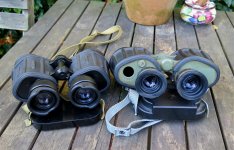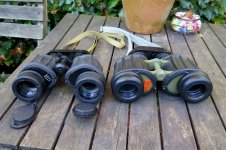smurf.for.mark
Well-known member
Hi, i havnt posted here for a few years but had my interest re kindled by the recent acquisition of a pair of czech military 6x30's and russian bpo 7x30's followed by a pair of Romanian IOR Valdada 7x40's and it didnt stop there! as now have a set of Serbian made zrak rd 7x40's!
the czech 6x30s are of an older design yet dated 1991, extremely light and with good optical performance.
the russian bpo 7x30 have excellent resolution but found a little lacking in low light.
the IOR 7x40 though is an astounding instrument! heavy at 900 gms with a warm cast but extremely sharp center field and contrast, excellent stray light control and low light performance. coupled with the low magnification and mass they are extremely stable in use and the eyecups are the most comfortable i have ever used.
my latest find is a pair of serbian made zrak rd 7x40's with very similar characteristics to the ior and an almost exact copy of the carl zeiss nva (licensed) it has a neutral image and is sharper a little further out into the field of view than the ior which is wide i think 8.5 degrees the same as the ior.
all have a range finding retical with the zrak's being tritium illuminated. the zrak's also have an inrared detector that can be swung into the field of view, basically a very dark filter that reacts to infrared light... not something im likely to need but it was interesting to play with. it charges in sunlight from the dark round window on the rear left prism plate.
just wondered if anyone else had an interest in modern military binoculars?
the czech 6x30s are of an older design yet dated 1991, extremely light and with good optical performance.
the russian bpo 7x30 have excellent resolution but found a little lacking in low light.
the IOR 7x40 though is an astounding instrument! heavy at 900 gms with a warm cast but extremely sharp center field and contrast, excellent stray light control and low light performance. coupled with the low magnification and mass they are extremely stable in use and the eyecups are the most comfortable i have ever used.
my latest find is a pair of serbian made zrak rd 7x40's with very similar characteristics to the ior and an almost exact copy of the carl zeiss nva (licensed) it has a neutral image and is sharper a little further out into the field of view than the ior which is wide i think 8.5 degrees the same as the ior.
all have a range finding retical with the zrak's being tritium illuminated. the zrak's also have an inrared detector that can be swung into the field of view, basically a very dark filter that reacts to infrared light... not something im likely to need but it was interesting to play with. it charges in sunlight from the dark round window on the rear left prism plate.
just wondered if anyone else had an interest in modern military binoculars?
Attachments
Last edited:







